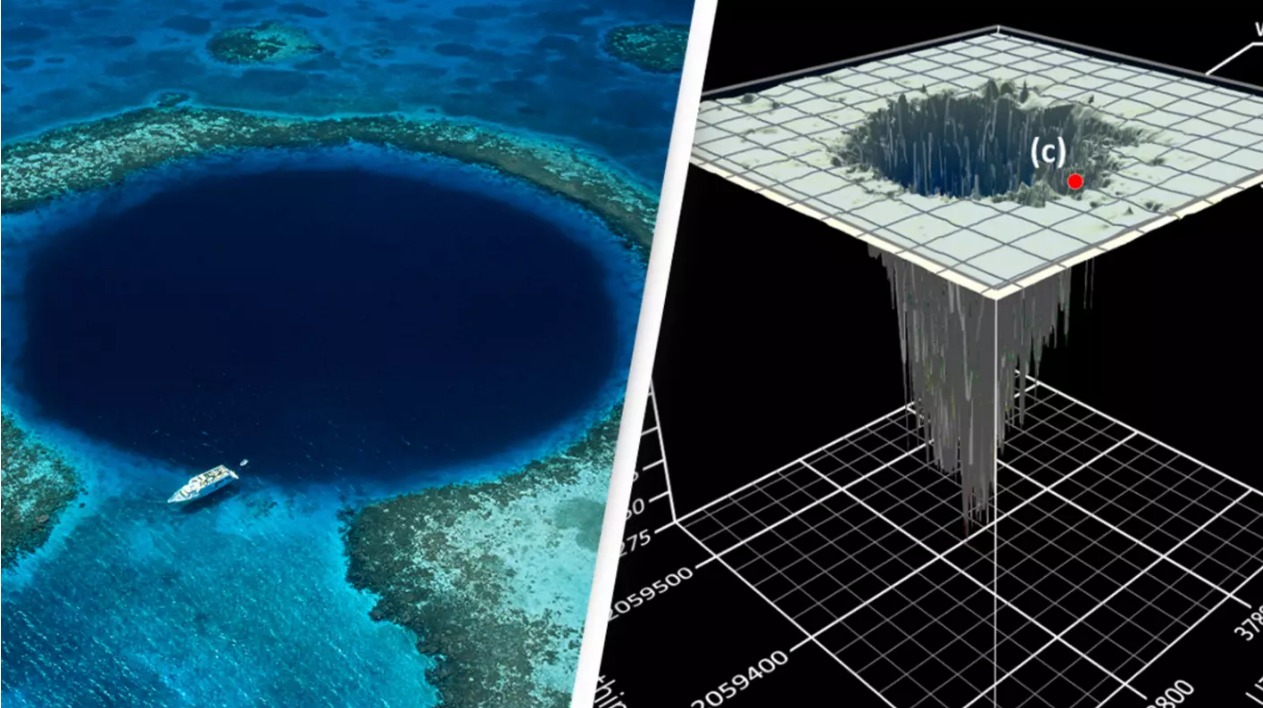Scientists have discovered just how large and deep the ocean can be as they have uncovered what appears to be the largest ever ‘blue hole’.
Sitting just outside the Yucatan Peninsula, near Mexico and Belize, the ‘deepest known blue hole’ in the world measures at least 1,380 feet (420 metres) below sea level.
And to make things even more mind-boggling, scientists haven’t even reached the bottom yet.
Discussed in a research paper published in the journal Frontiers in Marine Science, scientists have detailed the huge expanse and what it could mean for future studies of underwater life and how ‘blue holes’ are formed.
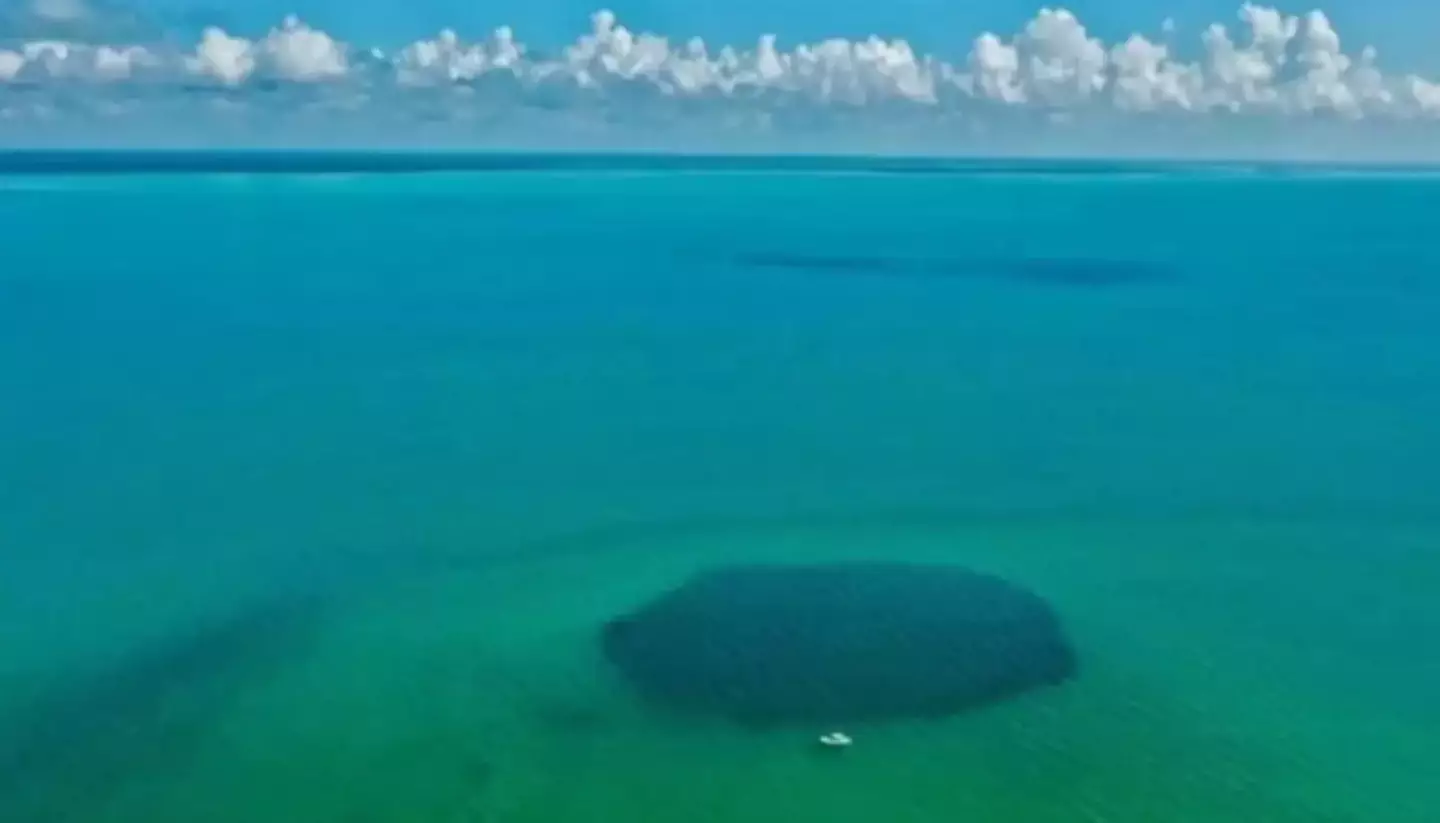
Scientists aren’t sure they’ve even reached the bottom of the world’s largest ‘blue hole’ yet. (Joan A. Sánchez-Sánchez)
These ‘blue holes’ are actually marine caves, believed to have been formed and carved over thousands of years by glacial runoff during the Ice Age.
Typically measuring hundreds of metres below the ocean’s surface, they present a fascinating study and so far, many divers and marine explorers have failed to reach the very bottom to see what happens at the base of them.
Limited oxygen can be one of the biggest concerns for those keen to dive in and see what’s in them, and some of these marine caves can be home to the gas hydrogen sulfide, making it toxic to be diving without the right training and equipment.
Initially, the largest ‘blue hole’ – known as Taam Ja’ Blue Hole (TJBH) – was thought to only measure 900 feet down, but in December last year it was calculated to be even deeper and stretch further towards the ocean floor.
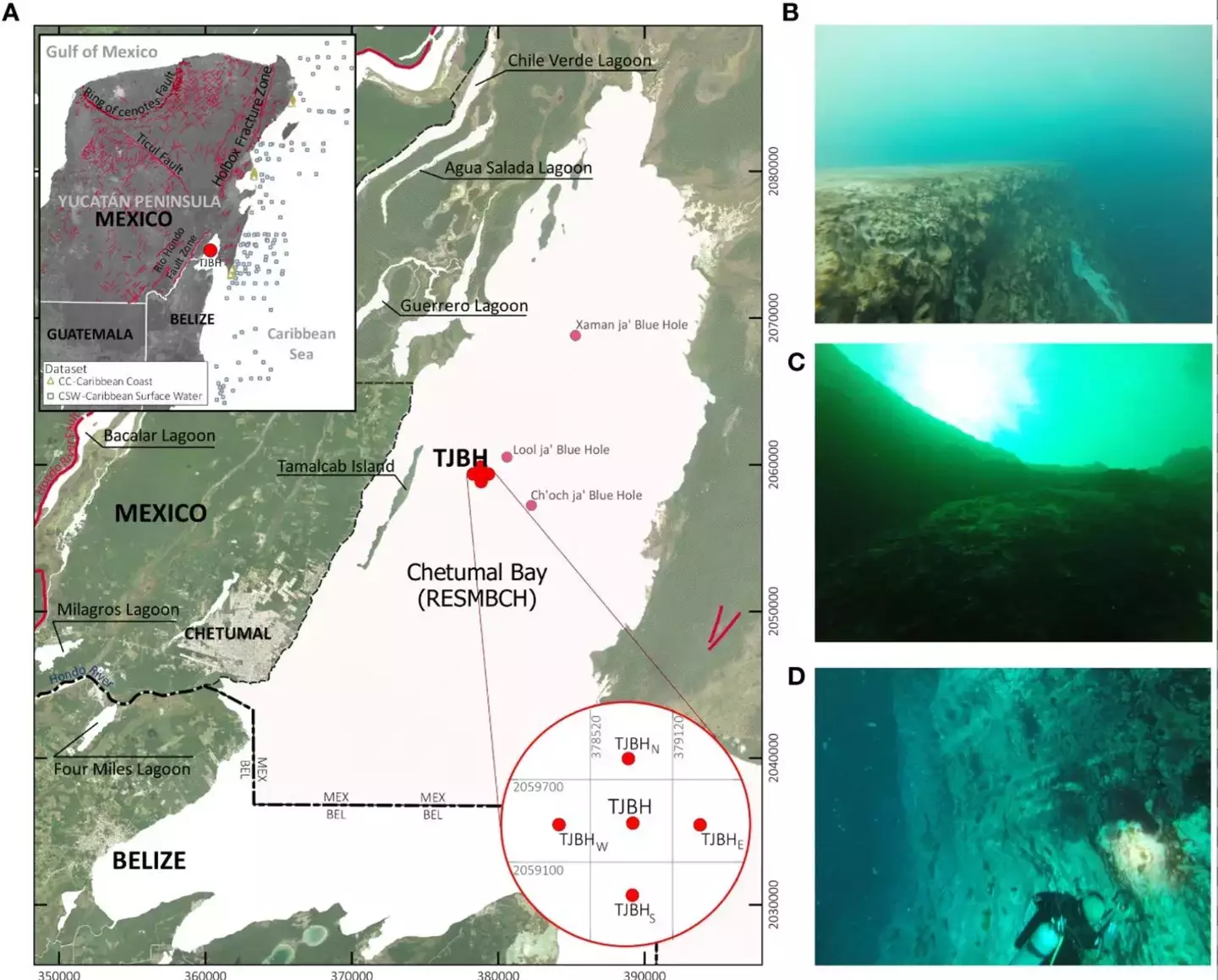
The Taam Ja’ Blue Hole measures over 1,300 feet. (Frontiers in Marine Science)
The previous incorrect measurements were thought to be down to limitations in the echo-sounder technology, which uses sound waves to determine depth and calculate how far down the hole stretches.
This time to get the right measurements, or at least get a more accurate view until they can finally reach the bottom, the science team used a conductivity, temperature and depth (CTD) profile which means they were able to get a better understanding of how far and how deep it reaches.
Whilst they haven’t reached the bottom yet, the CTD profile did stop at at 1,380 feet but can technically stretch to 1,640 feet so whether or not it did touch the bottom or simply was blocked is something the scientists are also still confirming.
Another interesting finding was that a layer of water below the 1,312 mark resembled the Caribbean Sea, hinting that there could be links between some of these underwater marine caves but more research will be needed.
Scientists collect completely new type of virus from 29,000 feet below the ocean
A new study reveals researchers analysed sediments scraped from the Mariana Trench.
Ella ScottPublished 20:29 21 Sep 2023 GMT+1
Scientists have found a completely new type of virus 8.9km below sea level.
That sounds terrifying, but thankfully it’s not as scary as it seems.
Researchers have recently identified the virus in sediments taken from the Mariana Trench in the western Pacific Ocean.
It is believed that this new virus belongs to a brand new family of ‘Siphoviruses’. The latter is known to only infect bacteria, meaning that humans cannot act as hosts.
However, this isn’t the first time scientists have discovered these bacteriophages – viruses that live and replicate in bacterial hosts.
A virus was previously discovered at a depth of 8.636km in the trench. Despite the multiple findings, the nature of these phages is still largely unknown.
In a recent study published in Microbiology Spectrum, international scientists have named the new bacteriophage vB_HmeY_H4907.
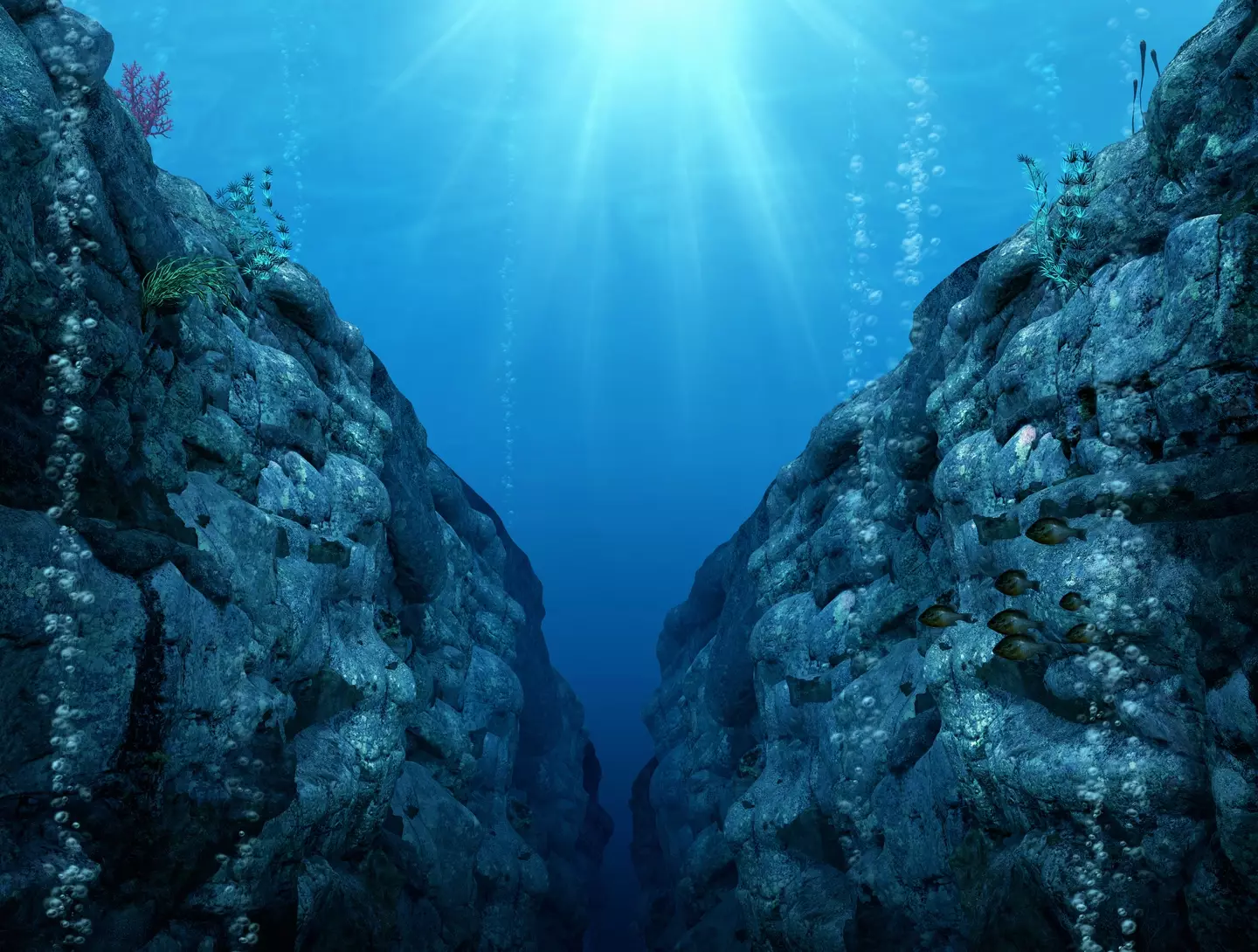
Getty Stock Images/ratpack223
They state it is the ‘deepest known phage isolated to date’ and say the new finding ‘represents a novel abundant viral family in the ocean.’
The virus was found in the hadal zone, the deepest parts of the ocean from 6km to 11km below sea level.
Regarding the uncovering of the phage, the team said: “The hadal trench is the planet’s least explored and the most mysterious environment, and it is the deepest habitat for life on Earth’s surface.
“Our understanding of hadal viruses has been greatly limited by the scarcity of isolated viruses in the hadal trenches.
“This study reported the discovery of a temperate phage…isolated from surface sediment from the Mariana Trench at the depth of 8,900 m. To our best knowledge, it is the deepest isolated siphovirus from the ocean.”
Giving an insight into the research team who found the virus, co-authors Min Wang, Yue Su and Yantao Liang told Motherboard: “We are marine virologists, and our research team’s primary focus lies in investigating the community structure, diversity, distribution patterns, regulatory mechanisms, and ecological roles of viruses and their hosts in various marine habitats, such as polar regions and the deep sea.Mysterious holes found in oceanCredit: NOAA Ocean Exploration, Voyage to the Ridge 20220 seconds of 2 minutes, 44 secondsVolume 90%
“Host bacteria was isolated from the sediments of the Mariana Trench by our collaborator Yu-Zhong Zhang’s team.
“Their research team has been exploring microbial life in various extreme environments, including the Mariana Trench, while we are primarily focused on viruses. Considering the unique nature of the trench, the likelihood of isolating viruses using conventional infection methods is pretty low.”
Elsewhere in the published research, the scientists stated that the phage infects a bacterial species in the Halomonas family of bacteria.
The latter has apparently adapted to deep hadal environments and are known for their ‘capacity to break down petroleum hydrocarbons, flourish in environments with high salt concentrations and alkaline pH, and high tolerance to contamination.’
As per the study, the phage is ‘abundant in the Mariana Trench’. This suggests it could play an ‘essential role’ in hadal environments like the Antarctic seafloor and deep-sea hydrothermal vents.
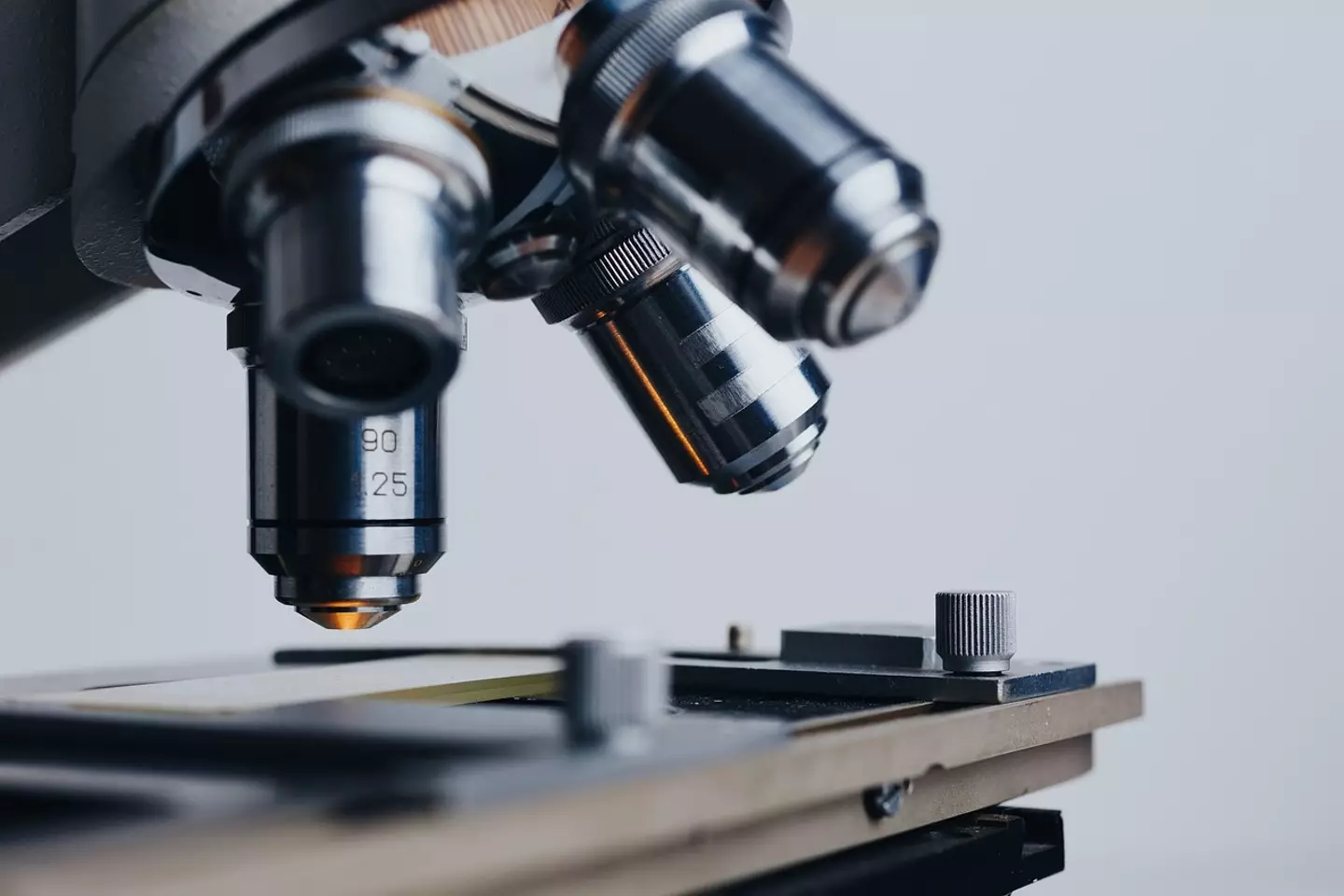
Konstantin Kolosov/Pixabay
Since discovering vB_HmeY_H4907, researchers have been able to conduct a genomic analysis of the phage.
The study reveals that it has an ‘icosahedron head’, which has an average diameter of 65 nanometers, and a ‘long, non-contractible tail’. The latter averages slightly longer than the head at 183 nanometers.
To conclude their study, scientists have stated that this research has ‘deepened’ their knowledge of hadal phages.
It’s also said that the genetic diversity and genomic features of the virus have been further explored to provide a ‘theoretical basis’ for more in-depth analysis.
So while this deep-sea virus cannot infect humans, it is crucial to continue studying it, due to it being described as ‘essential regulators of global ecology’.
Wang further stated that in the future, the group plans to investigate the ‘molecular machinery that drives interactions between deep-sea viruses and their hosts’.
Topics: Health, Science, Weird, World News

Ella Scott

Featured Image Credit: Schmidt Ocean Institute
Scientists make unbelievable discovery after spotting trail of crabs at the bottom of the ocean
The discovery was made in the Galápagos Islands
Niamh ShackletonPublished 16:44 3 Dec 2023 GMT
Scientists have found something in the Galápagos Islands that they’d long been searching for – with the help of some crabs.
A team of researchers spotted an chemical anomaly way back in 2008, which sparked them to start searching the general Galápagos Spreading Center (GSC) region.
The research was organized by the Schmidt Ocean Institute.Animation shows just how deep the ocean isCredit: YouTube / MetaBallStudios0 seconds of 5 minutes, 11 secondsVolume 90%
Expedition co-leader Jill McDermott, a chemical oceanographer at Lehigh University in Pennsylvania, explained to Live Science: « One of the anomalies that we look for is a lens of low oxygen water.
« Oxygen is completely removed through circulation in the seafloor. So the water that’s expressed at the seafloor is devoid of oxygen. »
They then followed the oxygen-poor, chemically enriched water, using a remotely operated vehicle to analyze the sea floor.
It was then that the trail of a type of crab called (bizarrely) squat lobsters were spotted who unintentionally led researchers to what they’d been looking for – a hydrothermal vent.
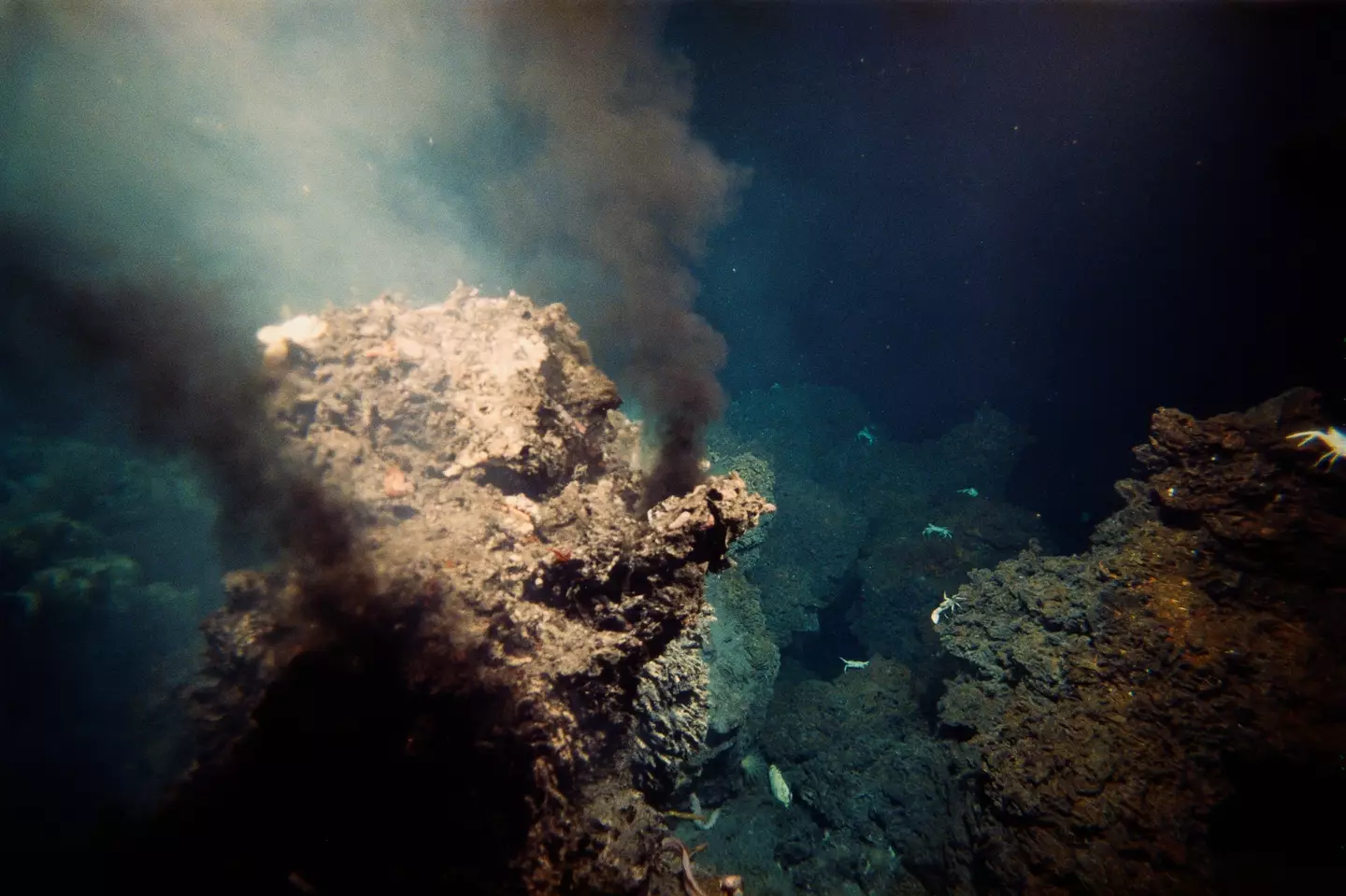
Ralph White/Getty
They spotted the dense population of galatheid crabs (genus Munidoposis) – aka squat lobsters – which led them to the new field located between the Cocos and Nazca tectonic plates roughly 250 miles north of the Galápagos Islands.
Upon following the ghostly white crabs, scientists discovered a sprawling 98,800 square feet field; which they’ve since dubbed ‘Sendero del Cangrejo’, or ‘Trail of the Crabs’.
It was in a similar area that the first ever hydrothermal vent was unveiled in the late 1970s.
There are thought to be over 500 hydrothermal vents dotted across the globe, but only half of these have actually been seen.
Hydrothermal vents can only occur in places with volcanic activity.
Cracks in the sea floor allow water to flow through the ocean crust, which is heated by the Earth‘s magma chambers.
Waters can hit temperatures of 400°C before it travels back into the ocean by hydrothermal vents.
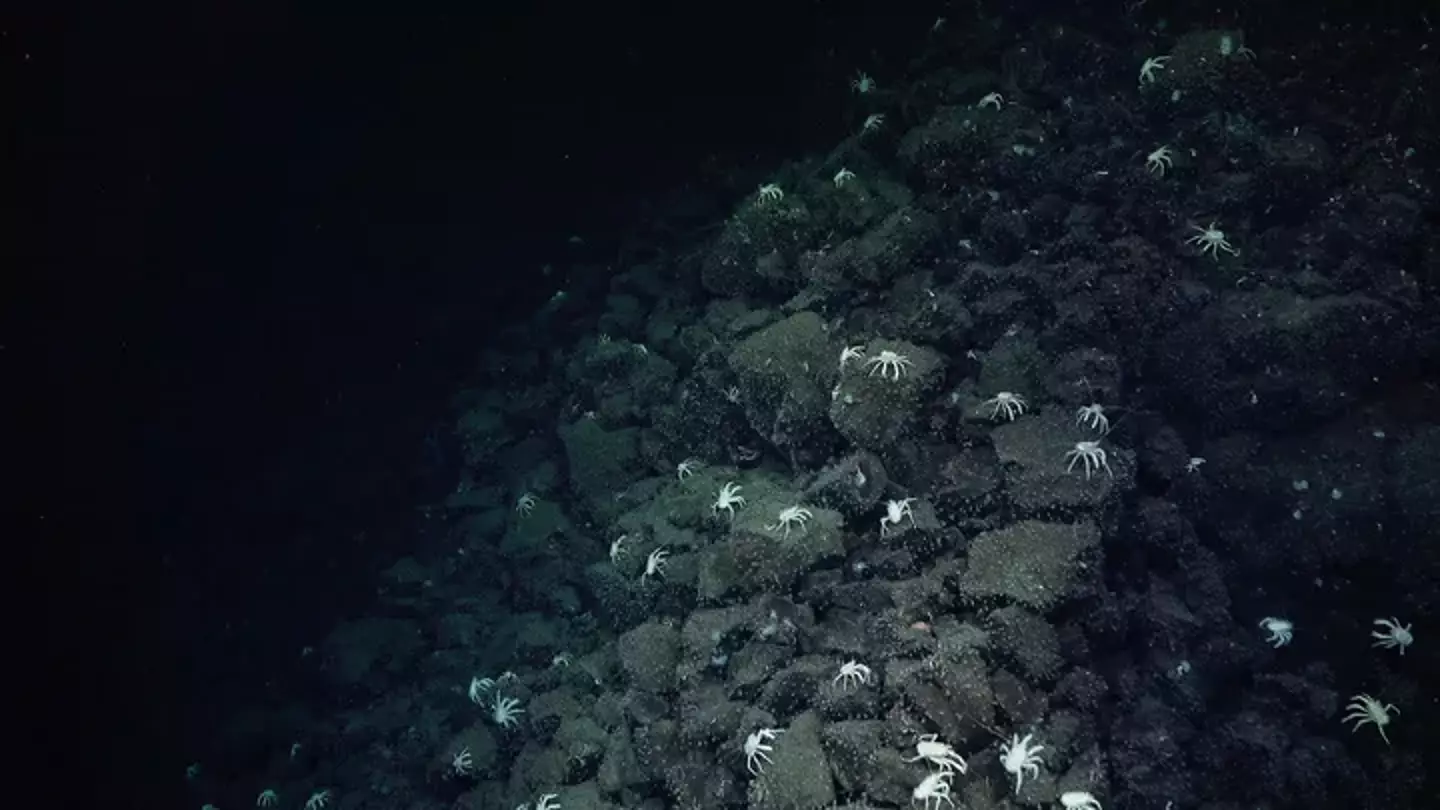
Schmidt Ocean Institute
The hostile environment that comes with living near a hydrothermal vent means there’s very little life nearby; only some crabs and tube worms are able to survive.
As well as the crabs, Roxanne Beinart, a biological oceanographer at the University of Rhode Island who co-led the expedition said they saw tube worms, clams and mussels in the vent field.
Bienart recalled: « There were giant tube worms, which can be a couple meters long.
« There were very large clams, sometimes called dinner plate clams, as well as mussels. »
Mollusks and octopuses have also been known to be able to live near hydrothermal vents.
Topics: News, World News, Science, Animals

Niamh Shackleton

Featured Image Credit: Roberto Machado Noa/Getty / Tuul & Bruno Morandi/Getty
Scientists say they’ve discovered ancestral home of all human beings
The team shared their findings after studying DNA, but other researchers have cast doubts
Emily BrownPublished 15:15 25 Apr 2024 GMT+1
Scientists in Australia sparked debate after claiming to have discovered the ancestral home of all modern humans.
For everything science has uncovered about evolution and the history of our planet over the years, there’s still so much we don’t know.How did Darwin come up with the theory of evolutionCredit: BBC News0 seconds of 5 minutes, 23 secondsVolume 90%
It seems like there are always new findings coming to light to provide clues about our past, and in 2019, those findings came in the form of mitochondrial DNA.
Professor Vanessa Hayes, a geneticist at the Garvan Institute of Medical Research in Sydney, and her team analysed 1,217 samples of mitochondrial DNA, which is passed down from mother to child.
The DNA came from people living in southern Africa, with Hayes noting that ‘we have known for a long time that modern humans originated in Africa and roughly 200,000 years ago’.
However, she noted that ‘what we hadn’t known until this study was where exactly’ humans came from.
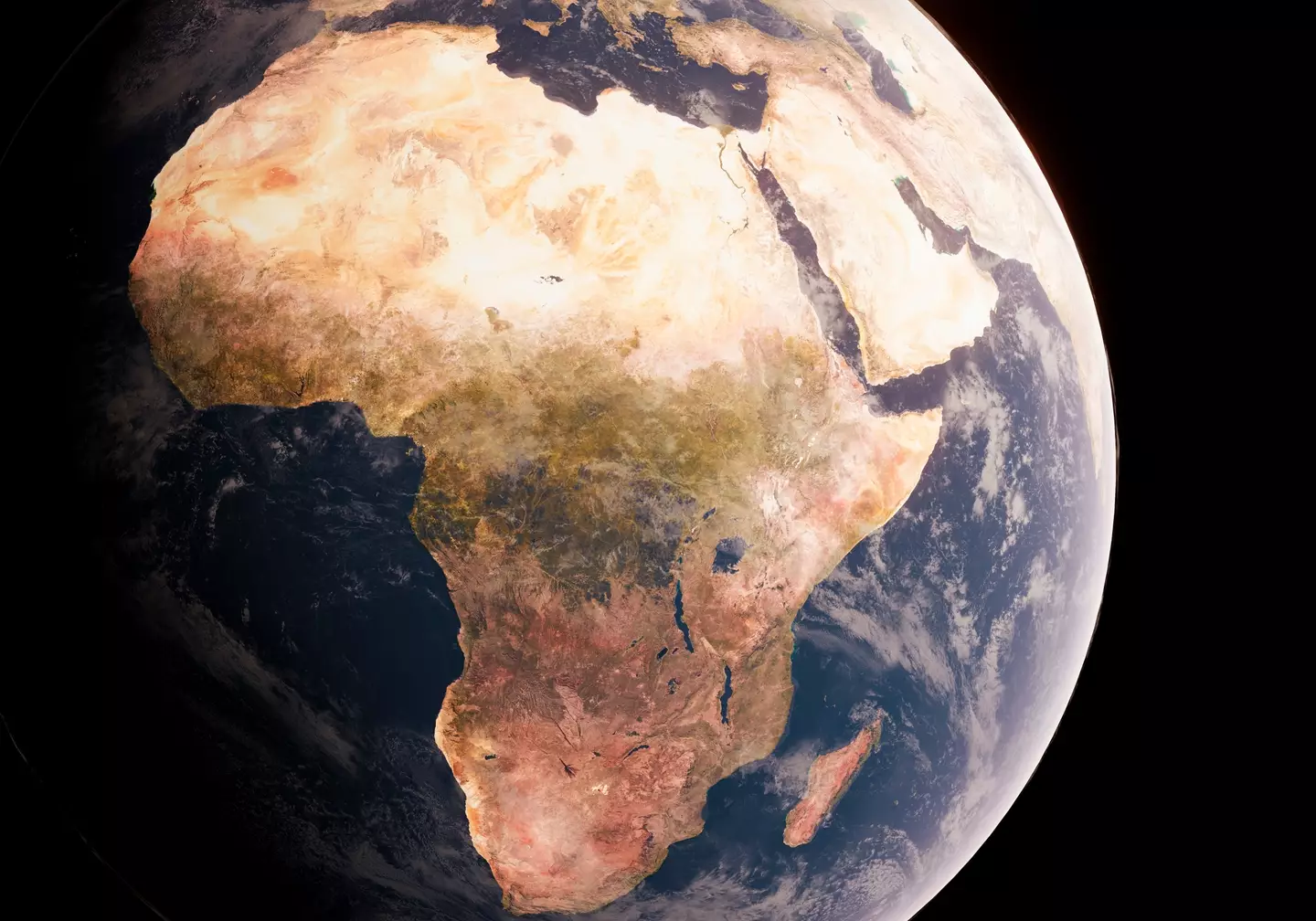
Scientists have long known humans originated from Africa. (Getty Stock Photo)
Using the DNA, the team mapped out the oldest known maternal line of humans alive today and found that it points back to an ‘ancestral home’ that spreads from Namibia, across Botswana and into Zimbabwe.
Hoping to further pinpoint the ancestral home of humans, the team then used geological, archaeological and fossil evidence to figure out the area that may have made a good home.
Through this research, they found that a body of water which would have been Africa’s largest ever lake system once existed in the area, and that it broke up into a huge wetland approximately 200,000 years ago.
Hayes explained: “It would have been very lush and it would have provided a suitable habitat for modern humans and wildlife to have lived. »
The lake, located south of the Zambezi river, could have sustained our ancestors for 70,000 years, according to the study.
However, after the study was published in the journal Nature, other scientists cast doubt on the findings.

Not all scientists are in agreement about the findings. (Getty Stock Photo)
According to The Guardian, Chris Stringer, who studies human origins at the Natural History Museum in London, commented: “I’m definitely cautious about using modern genetic distributions to infer exactly where ancestral populations were living 200,000 years ago, particularly in a continent as large and complex as Africa.
“Like so many studies that concentrate on one small bit of the genome, or one region, or one stone tool industry, or one ‘critical’ fossil, it cannot capture the full complexity of our mosaic origins, once other data are considered.”
Sarah Tishkoff, a geneticist at the University of Pennsylvania, added: “It is not possible to make inferences about the geographical origin of modern humans in Africa based solely on patterns of variation in modern populations. This is because humans migrate over long distances.
« They migrated out of Africa and across the globe within the past 80,000 years and they have migrated across Africa in the recent and ancient past.”
Topics: Science, World News

Emily Brown
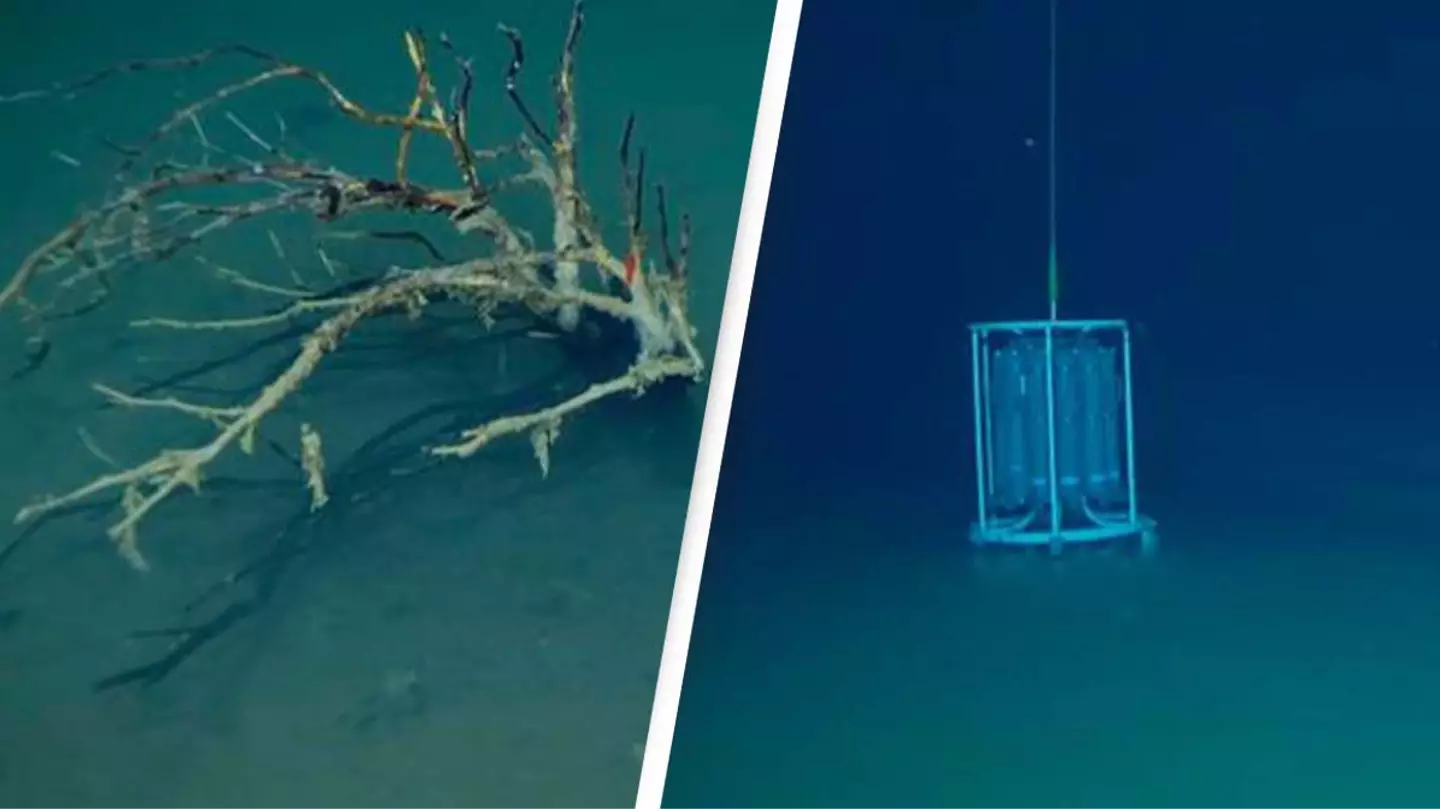
Featured Image Credit: OceanX
‘Death pool’ at bottom of the ocean instantly kills everything that enters it
Abandon hope all ye who enter the death pool, the name ought to be a bit of a giveaway
Joe HarkerPublished 15:19 19 May 2023 GMT+1
There’s a hole, there’s a hole, there’s a hole at the bottom of the sea and it kills pretty much anything which is foolish enough to try and see what’s inside.
Deep beneath the surface of the Red Sea there’s a series of deep sea brine pools which almost no creature of the sea can survive.
They were found by a team of researchers from the University of Miami and further study could help uncover some of the secrets about what this planet of ours was like in the early days.
A total of four of these ‘death pools’ were discovered on the sea floor by the researchers, with three of them being no larger than 10 square metres in diameter but the biggest of the four being about 10,000 square metres.
It’s one of the most extreme environments on Earth, with no oxygen and yet absolutely teeming with all sorts of life, and as far as scientists know there’s only a few dozen of them in the entire world.
While the pools themselves are teeming with microbes that can survive in the extreme brine, pretty much any other denizens of the deep coming into contact with these pools are done for.
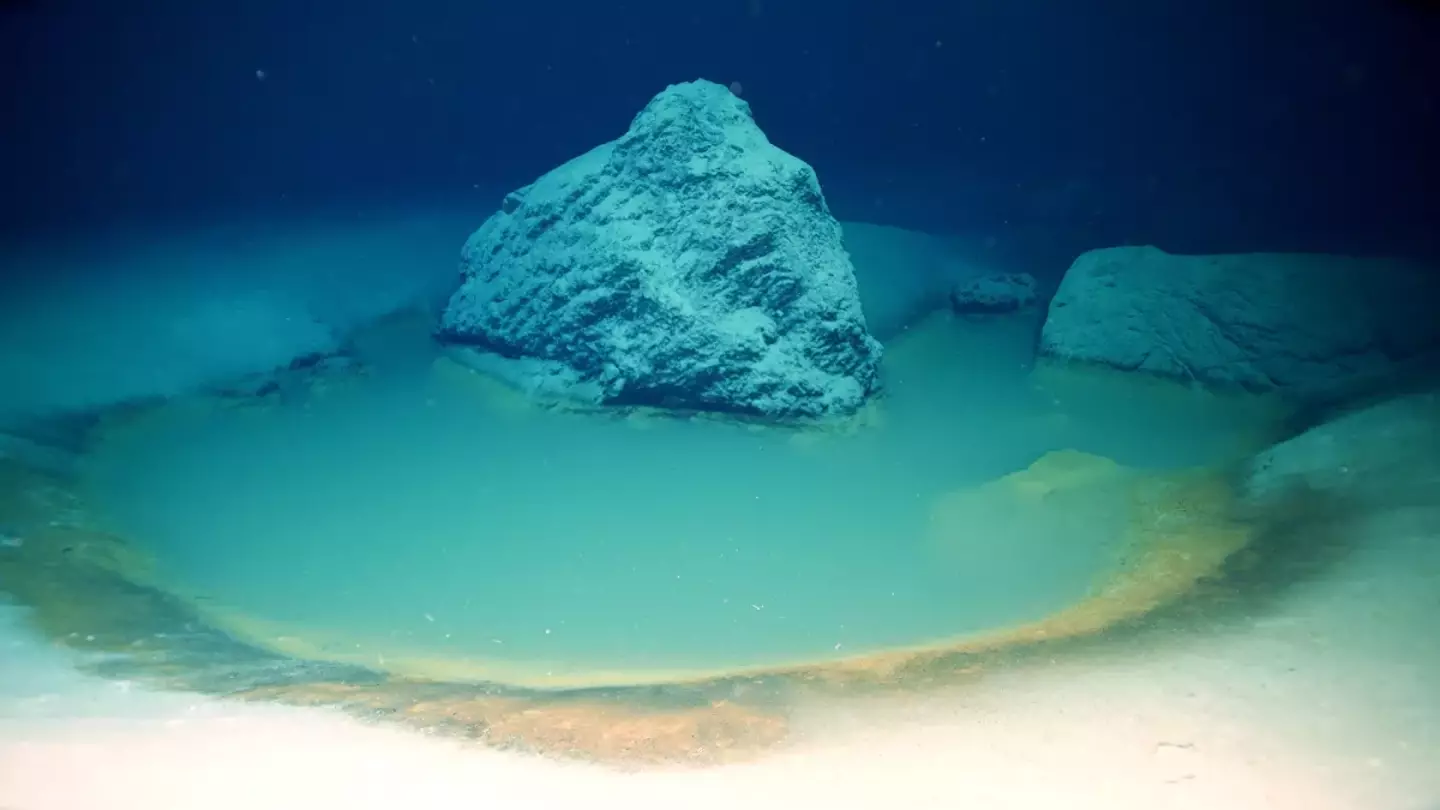
OceanX
With no oxygen in the brine any sea creature that needs the element (basically all of them) is either killed instantly or becomes stunned and ends up helpless.
Those creatures that aren’t instantly killed by the oxygen-less brine are easy pickings for patient predators lurking nearby to gobble them up.
Professor Sam Purkis, lead author of the study into the ‘death pools’ discovered at the bottom of the ocean, told Live Science these pools could hold the key to our understanding what things were like when life first appeared on our planet.
« Deep-sea brine pools are a great analog for the early Earth and, despite being devoid of oxygen and hypersaline, are teeming with a rich community of so-called ‘extremophile’ microbes, » he said, before suggesting that what we learn here could help us find new life far beyond the stars.
« Studying this community hence allows a glimpse into the sort of conditions where life first appeared on our planet, and might guide the search for life on other ‘water worlds’ in our solar system and beyond. »
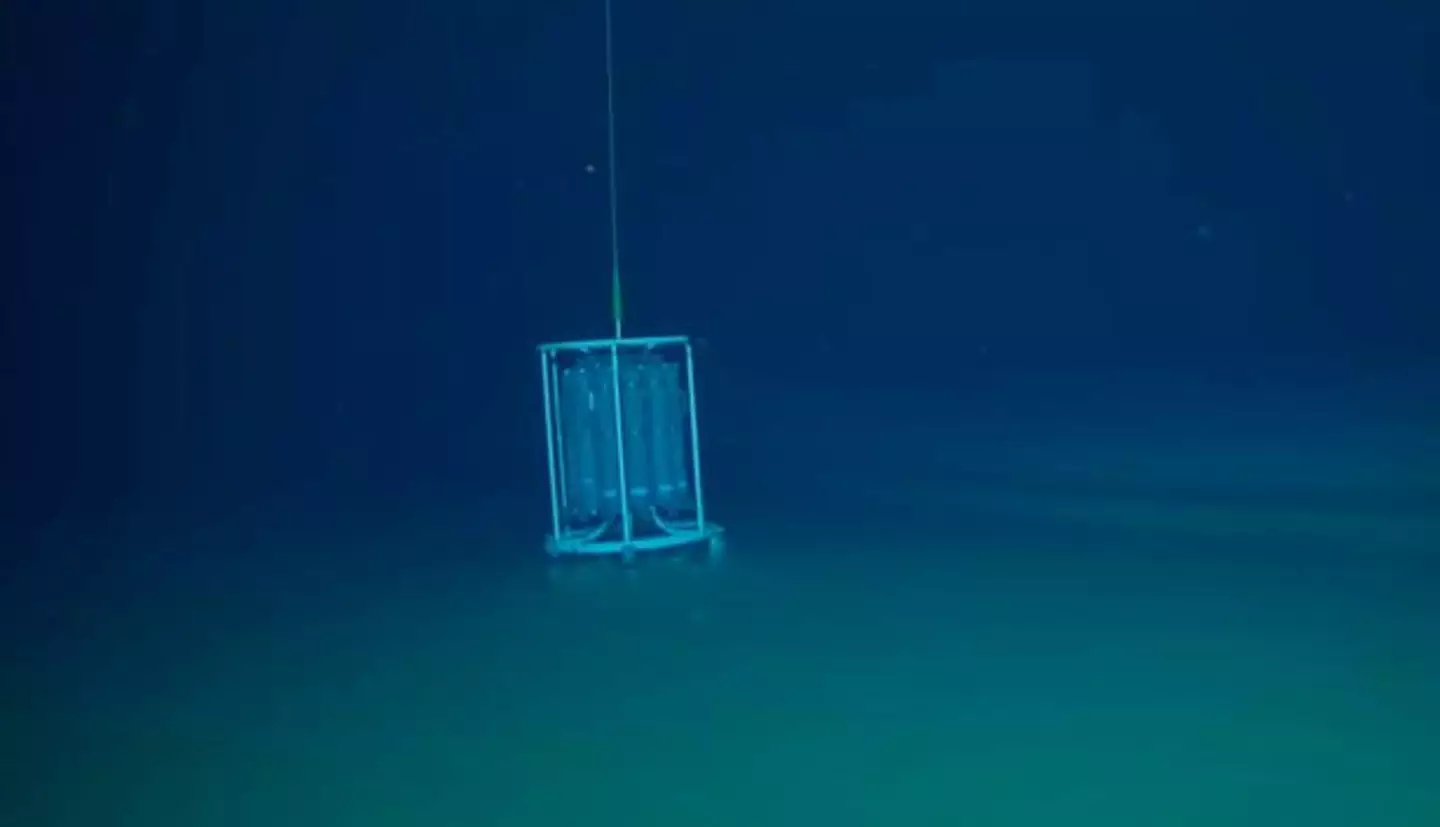
OceanX
While fish use the pools to hunt anything that gets too close due to their inhospitable nature to almost all creatures, the lack of animals that would normally live on the sea bed and churn it up aren’t in these pools.
That means the sediment and sea bed in the pools could be pretty much the same as it’s always been and Professor Purkis said the sedimentary layers in the pools were ‘exquisitely intact’.
Even below our oceans there’s a massive amount of water 400 miles beneath our feet where the supply of water is larger than all the oceans of our planet combined.
Meanwhile the part of the world where these ‘death pools’ are located will one day be home to a new ocean as the African, Arabian and Somali tectonic plates move away from each other and very slowly split the earth.
There are also other holes at the bottom of the sea through which water is ‘gushing out like a firehose’, though at least it’s going somewhere that’s already wet.


